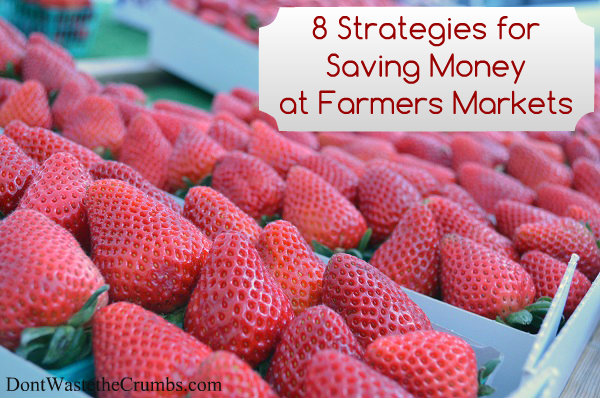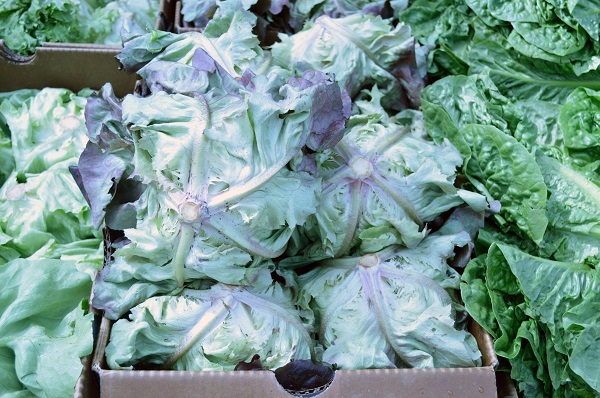April 1 is the traditional opening day of the season for many farmers markets across the country and with an exceptionally long and cold winter, it couldn’t come fast enough!
While shopping at local markets can be a lot of fun and a great way to try new foods, the cost of local and specialty produce can add up, if we’re not careful. Here are eight strategies for saving at the farmers market this season:
1. Shop With a Flexible List
Rule #1 of shopping is always – make a list! Before you leave the house, look at your meal plan for the next 7-10 days and make a detailed shopping list that includes the name of each item you need and how much you need (quantity). When it comes to produce, I also recommend including what meal the item is planned for, incase you find something at a better price that can easily be substituted, such as yellow squash for zucchini in summer squash pasta, or nectarines for peaches in oatmeal breakfast crumble.
2. Know What’s in Season
In-season produce is usually more affordable, better tasting and contains more nutrients compared to produce that is not in season and is shipped from a far away location. Know what’s in season before you shop using this cool page from the Natural Resources Defense Council. It allows you to see what’s in-season by state, by month and by food!
Another option is Lovacore, a free app that shows you what’s in season and what local markets carry what you’re looking for. For those who prefer the paper/pencil method, download a free in-season printable guide.
3. Visit Several Markets in Your Area
I live in a relatively small town, but there are 11 farmers markets within a 20-mile radius and there is an enormous variety at each one – including the prices. For example, I visited two farmers markets on the same day. One market had conventional apples for $1.69 per pound and were not labeled as local. Another had local, organic apples for just $1.50 per pound – a difference of almost 20¢/lb in favor of the locally-grown organic variety!
Get to know the markets in your area and be able to distinguish which is the most affordable, which is best for organic items, and which offers those unique produce items that are fun to experiment with. Plan your trips to each market according to your shopping list and your budget. If you’re new to shopping at farmers markets, or need help finding some in your area, visit LocalHarvest.org or EatWellGuide.org.
4. Know What’s on Sale in Stores
I love supporting local farms, but sometimes shopping at grocery stores is the better option for a frugal grocery budget. Before you leave for the market, compare your shopping list with the sales circulars from your local stores and write down the sale prices. Then when you’re at the market, compare the stand prices against the prices you wrote down. But remember, choosing the lowest price isn’t always the best, since it might mean poorer quality and making an extra trip, thereby costing more in the long run in gas and time.
5. Walk the Entire Market First, Before Making Any Purchases
Not only do prices vary from market to market, but they can vary greatly from stand to stand within the same market! For example, the Swiss chard you see above on the left is $2 per bunch, while the Swiss chard on the right is $1.50 per bunch – and they’re both organic!
So before you buy anything, walk the entire market from end to end, noting the prices of the items on your shopping list along the way. Then make a second pass through and choose the stands that have the best price for the best quality.
6. Shop the Clean 15 and Dirty Dozen
These lists, published yearly by the EWG, are a super helpful yes/no guide to buying organic. Grapefruit, avocados and onions rank very low in terms of pesticide residue, so you can save money by opting not to buy these organic. This will allow you to better afford to purchase organic for items that do rank high with pesticide residue, like strawberries, peaches and celery.
On the other hand, don’t write off vendors who aren’t certified organic. The process for becoming certified is very time-consuming and expensive and many small family farms just can’t afford to be certified, although they still follow organic practices. Ask if they use chemical pesticides or fertilizers or more natural methods instead, and what those methods are.
[Note from Kelly: I personally recommend getting to know your local farmers by discussing with them their farming methods and visiting their farms. Case in point, Tanaka Farms in Southern CA, is not organic certified but does follow organic practices and has farm tour visits and explains how they grow their produce. So to Tiffany’s point, yes, for some family farms it truly is an expensive process to be certified. But of course, we do have to be wary of those who would be dishonest. That’s why getting to know your local farmers is so important.]
7. Buy “Seconds”
The farmers are looking to sell their foods, even if they’re ugly or misshapen. These are often bagged and priced separately, or in a bin of their own, and marked down accordingly. Take advantage of the deal if those items are on your list.
I’ve also seen venders sort through their boxes in the middle of the day, removing the foods that aren’t in tip-top shape. If you see someone doing this, ask them if they’re selling those less-than-stellar items and how much they’re selling them for. You might want to have a price in mind as well, incase they’ve never been asked for their ugly foods before.
8. Bargain When Buying in Bulk
Farmers work very hard to provide quality food, and the prices reflect this. It can be insulting to attempt to bargain with them over one or two heads of lettuce that were just cut from the field within the past 24-48 hours. However, if you’re willing to buy 5-10lbs of something, they’re often willing to shave off a few dollars. Just be sure you have a plan for all the produce so it doesn’t go to waste!
BONUS! Other tips to make your experience at the farmers market a good one:
- Bring Cash – smaller bills and change if possible
- Bring Your Own Bag – consider bringing back glass jars, egg crates and pallet/flat containers if you previously bought them from the vendors. Some offer cash back for these items.
- Arrive Early for Best Selection
- Shop 30 Minutes Before Close for Possible Deals – Many people swear by this, but not all farmers discount their items just so they don’t have to bring them home! It’s worth a try once or twice though, to either rule the possibility out, or to have a new savings strategy!
What are your favorite tips for saving money at farmers markets? Leave them in the comments! We’d love to hear from you!
Note from Kelly: Don’t miss all of the other great budgeting posts that Tiffany has shared here. Simply click here and keep scrolling through to see her many helpful posts on how to save money on your food budget.













